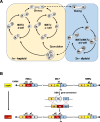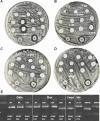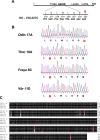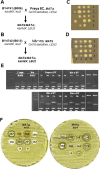Isolation and characterization of haploid heterothallic beer yeasts
- PMID: 39841271
- PMCID: PMC11754353
- DOI: 10.1007/s00253-024-13397-8
Isolation and characterization of haploid heterothallic beer yeasts
Abstract
Improving ale or lager yeasts by conventional breeding is a non-trivial task. Domestication of lager yeasts, which are hybrids between Saccharomyces cerevisiae and Saccharomyces eubayanus, has led to evolved strains with severely reduced or abolished sexual reproduction capabilities, due to, e.g. postzygotic barriers. On the other hand, S. cerevisiae ale yeasts, particularly Kveik ale yeast strains, were shown to produce abundant viable spores (~ 60%; Dippel et al. Microorganisms 10(10):1922, 2022). This led us to investigate the usefulness of Kveik yeasts for conventional yeast breeding. Surprisingly, we could isolate heterothallic colonies from germinated spores of different Kveik strains. These strains presented stable mating types in confrontation assays with pheromone-sensitive tester strains. Heterothallism was due to inactivating mutations in their HO genes. These led to amino acid exchanges in the Ho protein, revealing a known G223D mutation and also a novel G217R mutation, both of which abolished mating type switching. We generated stable MATa or MATα lines of four different Kveik yeasts, named Odin, Thor, Freya and Vör. Analyses of bud scar positions in these strains revealed both axial and bipolar budding patterns. However, the ability of Freya and Vör to form viable meiotic offspring with haploid tester strains demonstrated that these strains are haploid. Fermentation analyses indicated that all four yeast strains were able to ferment maltose and maltotriose. Odin was found to share not only mutations in the HO gene, but also inactivating mutations in the PAD1 and FDC1 genes with lager yeasts, which makes this strain POF-, i.e. not able to generate phenolic off-flavours, a key feature of lager yeasts. These haploid ale yeast-derived strains may open novel avenues also for generating novel lager yeast strains by breeding or mutation and selection utilizing the power of yeast genetics, thus lifting a block that domestication of lager yeasts has brought about. KEY POINTS: • Haploid Kveik ale yeasts with stable MATa and MATα mating types were isolated. • Heterothallic strains bear mutant HO alleles leading to a novel inactivating G217R amino acid change. • One strain was found to be POF- due to inactivating mutations in the PAD1 and FDC1 gene rendering it negative for phenolic off-flavor production. • These strains are highly accessible for beer yeast improvements by conventional breeding, employing yeast genetics and mutation and selection regimes.
Keywords: HO gene; Breeding; Domestication; Fermentation; Lager yeast; Ploidy.
© 2025. The Author(s).
Conflict of interest statement
Declarations. Ethical approval: This article does not contain any studies with human participants or animals performed by any of the authors. Conflict of interest: The authors declare no competing interests.
Figures







Similar articles
-
Industrially Applicable De Novo Lager Yeast Hybrids with a Unique Genomic Architecture: Creation and Characterization.Appl Environ Microbiol. 2021 Jan 15;87(3):e02434-20. doi: 10.1128/AEM.02434-20. Print 2021 Jan 15. Appl Environ Microbiol. 2021. PMID: 33188002 Free PMC article.
-
Induction, separation and identification of haploid strains from industrial brewer's yeast.Wei Sheng Wu Xue Bao. 2015 Jan 4;55(1):22-32. Wei Sheng Wu Xue Bao. 2015. PMID: 25958679
-
Understanding brewing trait inheritance in de novo Lager yeast hybrids.mSystems. 2024 Dec 17;9(12):e0076224. doi: 10.1128/msystems.00762-24. Epub 2024 Nov 12. mSystems. 2024. PMID: 39530669 Free PMC article.
-
Microbe Profile: Saccharomyces eubayanus, the missing link to lager beer yeasts.Microbiology (Reading). 2018 Sep;164(9):1069-1071. doi: 10.1099/mic.0.000677. Microbiology (Reading). 2018. PMID: 30175956 Free PMC article. Review.
-
Brewing up a storm: The genomes of lager yeasts and how they evolved.Biotechnol Adv. 2017 Jul;35(4):512-519. doi: 10.1016/j.biotechadv.2017.03.003. Epub 2017 Mar 8. Biotechnol Adv. 2017. PMID: 28284994 Review.
References
-
- Badura J, Kiene F, Brezina S, Fritsch S, Semmler H, Rauhut D, Pretorius IS, von Wallbrunn C, van Wyk N (2023) Aroma Profiles of Vitis vinifera L. cv. Gewürztraminer must fermented with co-cultures of Saccharomyces cerevisiae and seven Hanseniaspora spp. Fermentation 9, 109 10.3390/fermentation9020109
-
- Bölker M, Genin S, Lehmler C, Kahmann R (1995) Genetic regulation of mating, and dimorphism in Ustilago maydis. Canad J Bot 73:320–325. 10.1139/b95-262
-
- Botstein D, Fink GR (1988) Yeast: an experimental organism for modern biology. Science 240(4858):1439–1443. 10.1126/science.3287619 - PubMed
-
- Chant J, Herskowitz I (1991) Genetic control of bud site selection in yeast by a set of gene products that constitute a morphogenetic pathway. Cell 65(7):1203–1212. 10.1016/0092-8674(91)90015-q - PubMed
MeSH terms
Grants and funding
LinkOut - more resources
Full Text Sources

